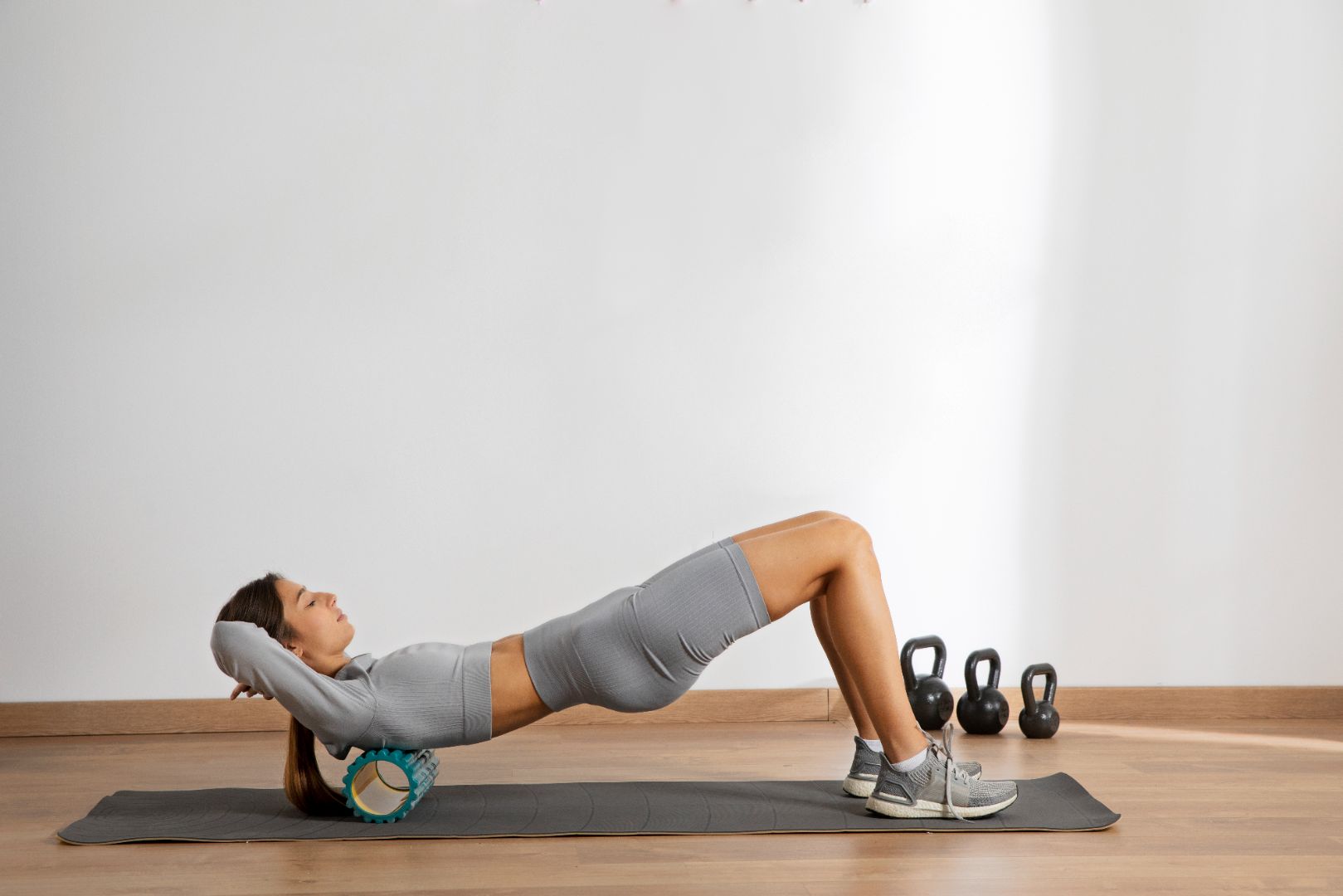If you’re feeling sore after a tough workout, foam rolling can speed up your recovery by easing tension, boosting blood flow, and reducing muscle pain.
This discomfort is commonly known as muscle soreness, a normal response to physical activity. One common type is DOMS (Delayed Onset Muscle Soreness), which typically appears 24 to 72 hours after exercise and results from microscopic muscle fiber tears, especially during eccentric contractions. It can make everyday movements difficult, slow you down, and negatively impact performance.
Foam rolling addresses these sore areas by applying pressure to the muscles and fascia—the connective tissue surrounding them. That’s why it has become a primary recovery method: it’s simple, accessible, and supports faster muscle repair, making it easier to stay consistent with your fitness goals.
In this article, we’ll discover how foam rolling for recovery works, why it’s effective, and how to use it correctly to relieve sore muscles.
Why is Foam Rolling Effective for Muscle Recovery?
Foam rolling is a way to give yourself a deep tissue massage after a tough workout session or prolonged sitting. When your muscles stay tight for too long, whether from exercise or inactivity, they can develop microtears, feel stiff, and build up metabolic waste.
If you are unfamiliar, foam rolling is a type of self-myofascial release, which means you’re applying pressure to tight or sore muscles to help them loosen up. When you roll slowly over those areas, it boosts blood flow, eases tension, and helps your muscles recover faster. It also tells your nervous system to chill a bit, which helps your body relax and move more freely.
Foam rolling on performance and recovery has been shown to improve strength recovery and reduce post-exercise soreness significantly. Supporting this, another study reinforced that foam rolling is an effective recovery tool, as experienced runners who use the tool after downhill running reported less muscle soreness and fatigue during their following training sessions compared to those who didn’t.
Foam rolling is a simple yet highly effective recovery tool that helps reduce muscle soreness, improve circulation, and speed healing after workouts. By targeting tight areas and promoting better blood flow, it supports mobility and overall performance, making it an essential part of a recovery routine.
What are the Benefits of Foam Rolling for Recovery?
You now understand how foam rolling aids recovery, as it offers a wide range of recovery benefits, both immediate and long-term, that help your body feel and perform better after physical activity. Now, let’s explore its key benefits in more detail.
- Reduces muscle soreness and tension
Foam rolling helps ease post-workout pain by breaking down adhesions and knots in muscle tissue. It facilitates quicker relief of stiffness and discomfort by relieving tension in tense areas.
- Improves blood flow and circulation
Applying pressure with a foam roller increases circulation to the targeted muscles. Increased blood flow brings more nutrients and oxygen to the body, accelerating tissue healing and eliminating waste products that cause pain.
- Enhances flexibility and range of motion
Frequent foam rolling improves joint mobility and the quality of movement by relaxing tight fascia. This can lower the chance of injury and improve performance.
- Supports faster recovery
Foam rolling stimulates the body’s natural repairing mechanisms, which speeds up muscle recovery. In addition to lowering inflammation, it speeds up the recovery of muscles from a workout.
- Decreases risk of injury
In the long run, foam rolling reduces the risk of overuse injuries and muscle joint imbalances by preserving healthy muscle tissue and maintaining or restoring mobility.
- Calms the nervous system
Activating pressure receptors in the skin and fascia through foam rolling may also tell the neurological system to relax and tone muscles, which is particularly helpful after tough workouts or stressful days.
When to Use Foam Rolling for Recovery
After learning the benefits, you should know when to use the tool. Depending on your recovery objectives, foam rolling can be done before, during, and after a workout. In this case, foam rolling can be used, not limited to post-workout.
- Before a workout:
During your warm-up, use foam rolling to improve circulation, release tense muscles, and get your body ready for exercise. This lowers the risk of injury and increases mobility.
- After a workout:
Use a foam roll to ease tense muscles, flush out metabolic waste like lactic acid, and speed the healing process. By doing this, post-workout soreness (DOMS) may be reduced.
- On rest or recovery days:
Gently rolling with foam maintains your muscles flexible and encourages blood flow, especially after extended periods of sitting or inactivity.
How Should You Use Foam Rolling for Recovery
As you learn when to use the tool, it’s essential to know how to use the foam roll. Knowing how to use the equipment can lessen your worries and avoid unnecessary risks.
- Target major muscle groups
Focus on large, commonly tight muscle areas such as the calves, hamstrings, quadriceps, glutes, upper back, and shoulders. These muscles are frequently the most tense due to daily posture patterns or exercise. To preserve balance and avoid compensatory injuries, give priority to painful, tight, or overused areas while also rolling supporting muscles.
- Roll slowly and with control
Take your time moving the foam roller; aim for roughly 1 inch per second. Your muscles and fascia won’t have enough time to react if you move quickly. ToIn order to help the tissue release tension and regain mobility, a slower pace guarantees that the roller exerts consistent pressure.
- Spend 30 to 60 seconds per muscle group
Give each muscle group at least 30 to 60 seconds, slowly rolling back and forth. Pause and hold for 10 to 30 seconds when you locate a trigger point, which is a sensitive or constricted area. This facilitates myofascial release and muscular relaxation for a more thorough recovery.
- Use proper form and alignment
When foam rolling, always keep your posture correct and engage your core to protect your joints and spine. Avoid rolling directly on the lower back, bones, or joints since this may cause pain or damage. To regulate pressure and range, use your arms or legs to support your body instead.
- Breathe deeply and stay relaxed
When foam rolling, deep, controlled breathing is essential. It lessens the natural tendency to stiffen up when uncomfortable and helps in signaling your neurological system to relax. The release will work better if your muscles are more relaxed.
Who Should Use Foam Rolling for Recovery
Once you get the hang of using a foam roller, you can learn that it is a multipurpose recovery technique that can help nearly everyone, regardless of age or fitness level, from athletes to everyday individuals. Whether you spend a lot of time sitting down or working out regularly, foam rolling helps keep your muscles healthy and enhances your movement.
Athletes
People who train regularly or play sports typically report feeling tired, stiff, and tense in their muscles. By keeping muscles balanced and flexible, foam rolling improves performance, assists in recovery between sessions, and helps avoid overuse problems.
Beginners
For beginners starting a workout routine, foam rolling is a great way to ease post-exercise soreness and improve flexibility. It’s an easy method to increase blood flow and ease tense muscles, which will make your exercise journey more comfortable and seamless.
Older Adults
Muscle circulation and elasticity naturally decrease with age. When done carefully, gentle foam rolling can facilitate joint mobility, lessen stiffness, and improve overall movement quality, making it a safe and efficient choice for healthy aging.
Sedentary Lifestyles
Prolonged sitting can cause bad posture, lower back pain, and tight hips. By fostering better posture and flexibility, increasing blood flow, and relaxing muscles, foam rolling helps offset these effects.
Common Foam Rolling Mistakes to Avoid for Safer Recovery
Foam rolling is a useful, affordable recovery technique that promotes everyone’s mobility, comfort, and long-term physical wellness. Although foam rolling is easy to use and widely available, improper use can lessen its advantages or, worse, cause pain or harm.
1. Rolling Too Quickly
If you move too quickly, your muscles and fascia won’t have enough time to react. Rapid rolling can avoid confined spaces and lessen the technique’s efficiency.
2. Skipping Tender Areas
Although it may seem normal to avoid sensitive areas, these places frequently require the greatest care.
3. Rolling Directly Over Bones or Joints
Directly pressing on your lower back, joints, or bones might irritate, hurt, or even injure them.
4. Spending Too Much Time on One Spot
Although maintaining pressure is beneficial, doing so for an extended period of time, particularly in extremely sensitive places, might result in bruising or worsen inflammation.
5. Using Bad Form or Poor Posture
Rolling, slouching, arching your back, or collapsing your core can put excessive stress on your shoulders and spine.
6. Not Breathing or Tensing Up
It is more difficult for the fascia to relax when you hold your breath or tense your muscles.
7. Using the Wrong Type of Foam Roller
If you’re new to foam rolling, using a roller that’s too rough or textured for your body may result in pain or bruises.
By avoiding these common mistakes, your foam rolling recovery is safe and as efficient as possible at easing discomfort, increasing range of motion, and promoting long-term muscle health.
What Type of Foam Rollers is Best for Muscle Recovery
Foam rollers are not all made equal; choosing the best foam rollers, depending on your experience, expertise, pain tolerance, and recovery objectives, will determine which one is best for you. The effectiveness and comfort of your recovery regimen might be greatly impacted by the type you choose.
1. Low-Density (Soft) Foam Rollers
Best for beginners, sensitive muscles, and older adults
Soft foam rollers offer mild pressure because they are composed of low-density foam. They’re perfect for folks who have never foam rolled before or who are recovering from stiffness or discomfort. Because of their lower intensity, these rollers are ideal for gradually introducing self-myofascial release without causing discomfort.
2. Standard-Density (Medium) Foam Rollers
Best for general muscle recovery, moderate soreness
The firmness and comfort of medium-density rollers are balanced. Without being extremely painful, they apply just enough pressure to loosen up tense muscles and increase blood flow. This kind is frequently utilized in home routines, physical therapy clinics, and gyms.
3. High-Density (Firm) Foam Rollers
Best for experienced users, deep tissue release
For athletes or people who frequently foam roll, high-density rollers are perfect since they are solid and provide a lot of pressure. They break up determined knots and tight fascia as they dive deeper into muscle tissue. They could be uncomfortable, though, if you’re not used to them.
4. Textured or Grid Foam Rollers
Best for targeted trigger point therapy, deep release
To resemble the hands of a massage therapist, these rollers have ridges, bumps, or grooves. They provide precise pressure to particular trigger points and muscle regions. Though they could be too strong for beginners, they are perfect for those who have persistent tightness or are looking for deep relief.
5. Vibrating Foam Rollers
Best for enhanced circulation, advanced recovery
Vibrating foam rollers speed up muscle healing and lessen discomfort by combining vibration and pressure therapy. Compared to ordinary rollers, they can help relax muscles and increase blood flow more efficiently. Suitable for advanced users or those wishing to spend money on tech-based recovery tools.
The correct foam roller and method might transform a basic healing aid into an effective component of your wellness regimen, beyond only relieving sore muscles or increasing long-term mobility.
Final Thoughts: Why You Should Use Foam Rolling for Recovery
Foam rolling has proven to be one of the most accessible and effective tools for muscle recovery. It supports healing by improving circulation, reducing soreness, and easing tightness.
After workouts, it helps release tension; on rest days, it maintains mobility; and for those who sit for long hours, it relieves daily stiffness. Just a few minutes a day can lead to noticeable improvements in flexibility, comfort, and performance. Foam rolling fits into almost any routine, and you can also do it at home.
The key is to roll with purpose: move slowly, breathe steadily, and target the major muscle groups. Whether you’re a beginner, choosing the right roller and applying proper form helps prevent mistakes and ensures results.
From speeding up recovery to preventing injuries, foam rolling continues to offer long-term benefits. With regular use and the right technique, it becomes more than just a recovery method; it becomes a reliable part of staying active and feeling your best.


